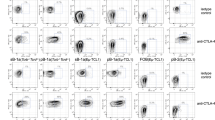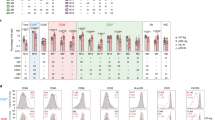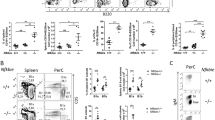Abstract
Vav-1 and Vav-2 are closely related Dbl-homology GTP exchange factors (GEFs) for Rho GTPases. Mutation of Vav-1 disrupts T cell development and T cell antigen receptor–induced activation, but has comparatively little effect on B cells. We found that combined deletion of both Vav-1 and Vav-2 in mice resulted in a marked reduction in mature B lymphocyte numbers. Vav-1−/−Vav-2−/− B cells were unresponsive to B cell antigen receptor (BCR)-driven proliferation in vitro and to thymus-indepen-dent antigen in vivo. BCR-stimulated intracellular calcium mobilization was greatly impaired in Vav-1−/−Vav-2−/− B cells. These findings establish a role for Vav-2 in BCR calcium signaling and reveal that the Vav family of GEFs is critical to B cell development and function.
This is a preview of subscription content, access via your institution
Access options
Subscribe to this journal
Receive 12 print issues and online access
$209.00 per year
only $17.42 per issue
Buy this article
- Purchase on Springer Link
- Instant access to full article PDF
Prices may be subject to local taxes which are calculated during checkout






Similar content being viewed by others
References
Benschop, R. J. & Cambier, J. C. B cell development: signal transduction by antigen receptors and their surrogates. Curr. Opin. Immunol. 11, 143–151 (1999).
Pillai, S. The chosen few? Positive selection and the generation of naive B lymphocytes. Immunity 10, 493–502 (1999).
Carsetti, R., Kohler, G. & Lamers, M. C. Transitional B cells are the target of negative selection in the B cell compartment. J. Exp. Med. 181, 2129–2140 (1995).
Melamed, D., Benschop, R. J., Cambier, J. C. & Nemazee, D. Developmental regulation of B lymphocyte immune tolerance comparmentalizes clonal selection from receptor selection. Cell 92, 173–182 (1998).
Kurosaki, T. Functional dissection of BCR signaling pathways. Curr. Opin. Immunol. 12, 276–281 (2000).
Kerner, J. D. et al. Impaired expansion of mouse B cell progenitors lacking Btk. Immunity 3, 301–312 (1995).
Khan, W. N. et al. Defective B cell development and function in Btk-deficient mice. Immunity 3, 283–299 (1995).
Fruman, D. A. et al. Impaired B cell development and proliferation in absence of phosphoinositide 3-kinase p85α. Science 283, 393–397 (1999).
Suzuki, H. et al. Xid-like immunodeficiency in mice with disruption of the p85α subunit of phosphoinositide 3-kinase. Science 283, 390–392 (1999).
Jumaa, H. et al. Abnormal development and function of B lymphocytes in mice deficient for the signaling adaptor protein SLP-65. Immunity 11, 547–554 (1999).
Pappu, R. et al. Requirement for B cell linker protein (BLNK) in B cell development. Science 286, 1949–1954 (1999).
Hayashi, K. et al. The B cell-restricted adaptor BASH is required for normal development and antigen receptor-mediated activation of B cells. Proc. Natl Acad. Sci. USA 97, 2755–2760 (2000).
Xu, S. et al. B cell development and activation defects resulting in xid-like immunodeficiency in BLNK/SLP-65-deficient mice. Int. Immunol. 12, 397–404 (2000).
Wang, D. et al. Phospholipase Cγ2 is essential in the functions of B cell and several Fc receptors. Immunity 13, 25–35 (2000).
Fruman, D. A., Satterthwaite, A. B. & Witte, O. N. Xid-like phenotypes: a B cell signalosome takes shape. Immunity 13, 1–3 (2000).
Bishop, A. L. & Hall, A. Rho GTPases and their effector proteins. Biochem. J. 348, 241–255 (2000).
Bustelo, X. R. Regulatory and signaling properties of the Vav family. Mol. Cell Biol. 20, 1461–1477 (2000).
Bustelo, X. R., Rubin, S. D., Suen, K. L., Carrasco, D. & Barbacid, M. Developmental expression of the vav protooncogene. Cell. Growth Differ. 4, 297–308 (1993).
Schuebel, K. E. et al. Isolation and characterization of murine vav-2, a member of the vav family of proto-oncogenes. Oncogene 13, 363–371 (1996).
Movilla, N. & Bustelo, X. R. Biological and regulatory properties of Vav-3, a new member of the Vav family of oncoproteins. Mol. Cell Biol. 19, 7870–7885 (1999).
Fischer, K. D., Tedford, K. & Penninger, J. M. Vav links antigen-receptor signaling to the actin cytoskeleton. Semin. Immunol. 10, 317–327 (1998).
Fischer, K. D. et al. Defective T-cell receptor signalling and positive selection of Vav- deficient CD4+ CD8+ thymocytes. Nature 374, 474–7 (1995).
Turner, M. et al. A requirement for the Rho-family GTP exchange factor Vav in positive and negative selection of thymocytes. Immunity 7, 451–460 (1997).
Kong, Y. Y. et al. Vav regulates peptide-specific apoptosis in thymocytes. J. Exp. Med. 188, 2099–2111 (1998).
Krawczyk, C. et al. Cbl-b is a negative regulator of receptor clustering and raft aggregation in T cells. Immunity 13, 463–473 (2000).
Zhang, R., Alt, F. W., Davidson, L., Orkin, S. H. & Swat, W. Defective signalling through the T- and B-cell antigen receptors in lymphoid cells lacking the vav proto-oncogene. Nature 374, 470–473 (1995).
Fischer, K. D. et al. Vav is a regulator of cytoskeletal reorganization mediated by the T- cell receptor. Curr. Biol. 8, 554–562 (1998).
Tarakhovsky, A. et al. Defective antigen receptor-mediated proliferation of B and T cells in the absence of Vav. Nature 374, 467–470 (1995).
Holsinger, L. J. et al. Defects in actin-cap formation in Vav-deficient mice implicate an actin requirement for lymphocyte signal transduction. Curr. Biol. 8, 563–572 (1998).
O'Rourke, L. M. et al. CD19 as a membrane-anchored adaptor protein of B lymphocytes: costimulation of lipid and protein kinases by recruitment of Vav. Immunity 8, 635–645 (1998).
Bachmann, M. F. et al. The guanine-nucleotide exchange factor Vav is a crucial regulator of B cell receptor activation and B cell responses to nonrepetitive antigens. J. Immunol. 163, 137–142 (1999).
Gulbranson-Judge, A. et al. Defective immunoglobulin class switching in Vav–deficient mice is attributable to compromised T cell help. Eur. J. Immunol. 29, 477–487 (1999).
Loder, F. et al. B cell development in the spleen takes place in discrete steps and is determined by the quality of the B cell receptor-derived signals. J. Exp. Med. 190, 75–89 (1999).
Klaus, G. G., Holman, M., Johnson-Leger, C., Elgueta-Karstegl, C. & Atkins, C. A re-evaluation of the effects of X-linked immunodeficiency (xid) mutation on B cell differentiation and function in the mouse. Eur. J. Immunol. 27, 2749–2756 (1997).
Doody, G. M. et al. Vav-2 controls NFAT-dependent transcription in B- but not T-lymphocytes. EMBO J. 19, 6173–6184 (2000).
Moores, S. L. et al. Vav family proteins couple to diverse cell surface receptors. Mol. Cell Biol. 20, 6364–7633 (2000).
Deckert, M., Tartare-Deckert, S., Couture, C., Mustelin, T. & Altman, A. Functional and physical interactions of Syk family kinases with the Vav proto-oncogene product. Immunity 5, 591–604 (1996).
Wu, J., Zhao, Q., Kurosaki, T. & Weiss, A. The Vav binding site (Y315) in ZAP-70 is critical for antigen receptor- mediated signal transduction. J. Exp. Med. 185, 1877–1882 (1997).
Fu, C., Turck, C. W., Kurosaki, T. & Chan, A. C. BLNK: a central linker protein in B cell activation. Immunity 9, 93–103 (1998).
Wienands, J. et al. SLP-65: a new signaling component in B lymphocytes which requires expression of the antigen receptor for phosphorylation. J. Exp. Med. 188, 791–795 (1998).
Kelly, M. E. & Chan, A. C. Regulation of B cell function by linker proteins. Curr. Opin. Immunol. 12, 267–275 (2000).
Han, J. et al. Role of substrates and products of PI 3-kinase in regulating activation of Rac-related guanosine triphosphatases by Vav. Science 279, 558–560 (1998).
Fu, C. & Chan, A. C. Identification of two tyrosine phosphoproteins, pp70 and pp68, which interact with phospholipase Cγ, Grb2, and Vav after B cell antigen receptor activation. J. Biol. Chem. 272, 27362–27368 (1997).
Hashimoto, S. et al. Identification of the SH2 domain binding protein of Bruton's tyrosine kinase as BLNK—functional significance of Btk-SH2 domain in B-cell antigen receptor-coupled calcium signaling. Blood 94, 2357–2364 (1999).
Su, Y. W. et al. Interaction of SLP adaptors with the SH2 domain of Tec family kinases. Eur J. Immunol. 29, 3702–3711 (1999).
Aman, M. J. & Ravichandran, K. S. A requirement for lipid rafts in B cell receptor induced Ca(2+) flux. Curr. Biol. 10, 393–396 (2000).
Guo, B., Kato, R. M., Garcia-Lloret, M., Wahl, M. I. & Rawlings, D. J. Engagement of the human pre-B cell receptor generates a lipid raft-dependent calcium signaling complex. Immunity 13, 243–253 (2000).
Weng, W. K., Jarvis, L. & LeBien, T. W. Signaling through CD19 activates Vav/mitogen-activated protein kinase pathway and induces formation of a CD19/Vav/phosphatidylinositol 3-kinase complex in human B cell precursors. J. Biol. Chem. 269, 32514–32521 (1994).
Tedder, T. F., Inaoki, M. & Sato, S. The CD19-CD21 complex regulates signal transduction thresholds governing humoral immunity and autoimmunity. Immunity 6, 107–118 (1997).
Crespo, P., Schuebel, K. E., Ostrom, A. A., Gutkind, J. S. & Bustelo, X. R. Phosphotyrosine-dependent activation of Rac-1 GDP/GTP exchange by the vav proto-oncogene product. Nature 385, 169–172 (1997).
Schuebel, K. E., Movilla, N., Rosa, J. L. & Bustelo, X. R. Phosphorylation-dependent and constitutive activation of Rho proteins by wild-type and oncogenic Vav-2. EMBO J. 17, 6608–6621 (1998).
Tybulewicz, V. L., Crawford, C. E., Jackson, P. K., Bronson, R. T. & Mulligan, R. C. Neonatal lethality and lymphopenia in mice with a homozygous disruption of the c-abl proto-oncogene. Cell 65, 1153–1163 (1991).
Ogilvy, S. et al. Transcriptional regulation of Vav, a gene expressed throughout the hematopoietic compartment. Blood 91, 419–430 (1998).
Zmuidzinas, A. et al. The Vav proto-oncogene is required early in embryogenesis but not for hematopoietic development in vitro. EMBO J. 14, 1–11 (1995).
Rolink, A., Kudo, A., Karasuyama, H., Kikuchi, Y. & Melchers, F. Long-term proliferating early pre B cell lines and clones with the potential to develop to surface Ig-positive, mitogen reactive B cells in vitro and in vivo. EMBO J. 10, 327–336 (1991).
Fong, G. H., Rossant, J., Gertsenstein, M. & Breitman, M. L. Role of the Flt-1 receptor tyrosine kinase in regulating the assembly of vascular endothelium. Nature 376, 66–70 (1995).
Rolink, A., Melchers, F. & Andersson, J. The SCID but not the RAG-2 gene product is required for S mu-S epsilon heavy chain class switching. Immunity 5, 319–330 (1996).
Acknowledgements
We thank J. Penninger and T. Wirth for critical reading of the manuscript, U. R. Rapp for support and A. Heiter and S. Rotzoll for technical help. We also thank J. Wienands and M. Reth for reagents used in initial studies and W.-D. Jin for help in the early stages of this work, which was initiated when A. C. and M. B. were at the Bristol-Myers Squibb Pharmaceutical Research Institute. Supported by grants from DFG (Fi2-1) and Thyssen Stiftung (to K.-D. F) and SFB465 (to L. N. and K.-D. F.).
Author information
Authors and Affiliations
Corresponding author
Rights and permissions
About this article
Cite this article
Tedford, K., Nitschke, L., Girkontaite, I. et al. Compensation between Vav-1 and Vav-2 in B cell development and antigen receptor signaling. Nat Immunol 2, 548–555 (2001). https://doi.org/10.1038/88756
Received:
Accepted:
Issue Date:
DOI: https://doi.org/10.1038/88756
This article is cited by
-
Characterization of the mechanism of action of lanraplenib, a novel spleen tyrosine kinase inhibitor, in models of lupus nephritis
BMC Rheumatology (2021)
-
Grb2 carboxyl-terminal SH3 domain can bivalently associate with two ligands, in an SH3 dependent manner
Scientific Reports (2017)
-
Rho guanine nucleotide exchange factors: regulators of Rho GTPase activity in development and disease
Oncogene (2014)
-
Moving towards a paradigm: common mechanisms of chemotactic signaling in Dictyostelium and mammalian leukocytes
Cellular and Molecular Life Sciences (2014)
-
HOX genes regulate Rac1 activity in hematopoietic cells through control of Vav2 expression
Leukemia (2013)



